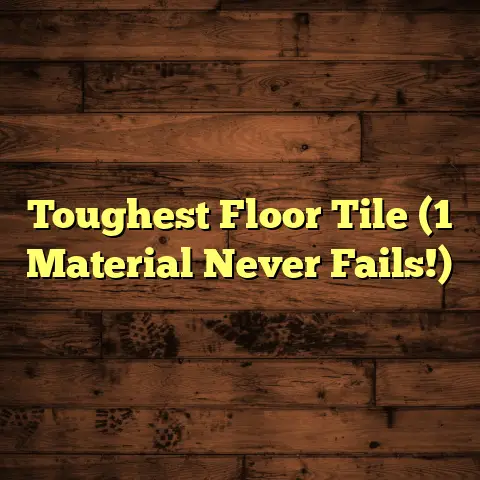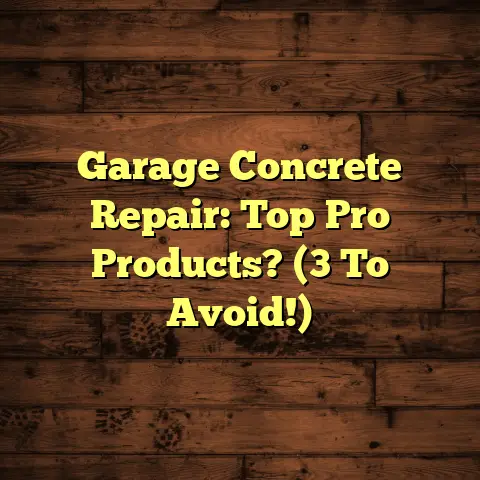DIY Garage Flooring? (Before You Pour!)
Have you ever walked into your garage, felt the cold concrete under your feet, and thought, “There’s GOT to be a better way”?
I get it. For years, garages have been the forgotten stepchild of home improvement. But think about it.
Your garage could be more than just a place to park your car and store holiday decorations. It could be a workshop, a home gym, or even a creative studio.
The key to unlocking that potential?
Your garage floor.
And before you jump in headfirst with the first flooring solution you see, there’s prep work to do.
I’m here to guide you through it.
As a flooring contractor with years of experience, I’ve seen firsthand what works and what doesn’t.
This article is your ultimate guide to DIY garage flooring, ensuring you’re not just pouring money down the drain.
1. Understanding Garage Flooring Options
Let’s talk options. You’ve got more choices than you might think when it comes to garage flooring.
Each has its own strengths and weaknesses.
I’m going to break down the most popular ones.
Epoxy Flooring: The Tough Guy
Epoxy is a two-part system (resin and hardener) that, when mixed, creates a durable, chemical-resistant coating.
Think of it as a super-tough shield for your concrete.
Pros:
- Durability: Can withstand heavy traffic, impacts, and chemicals (like oil and gasoline).
- Aesthetics: Available in various colors and flake options for a custom look.
- Easy to Clean: Smooth, non-porous surface resists stains and spills.
- Long-lasting: With proper application and maintenance, it can last for years.
Cons:
- Preparation is Key: Requires meticulous surface preparation (cleaning, etching, repairing cracks).
- Application Time: Can be time-consuming, especially for larger garages.
- Fumes: Some epoxy products can release strong odors during application, requiring proper ventilation.
- Moisture Sensitivity: Moisture in the concrete can cause epoxy to peel or bubble.
My Take: Epoxy is a fantastic choice if you’re looking for a durable and visually appealing floor, but you must be prepared to put in the prep work.
Garage Floor Tiles: The Puzzle Master
Garage floor tiles, typically made of PVC or rubber, interlock to create a floating floor.
Think of them as giant, durable puzzle pieces.
Pros:
- Easy Installation: Relatively simple to install, even for beginners.
- Durability: Resistant to impacts, chemicals, and stains (depending on the material).
- Comfort: Provides a more comfortable surface to stand on compared to concrete.
- Portability: Can be easily removed and reinstalled if needed.
Cons:
- Cost: Can be more expensive than epoxy, depending on the material and quality.
- Seams: Dirt and debris can accumulate in the seams between tiles.
- Moisture: Moisture can get trapped underneath the tiles, potentially leading to mold or mildew.
- Subfloor Imperfections: May not be suitable for severely uneven or damaged subfloors.
My Take: Tiles are a great option if you want a relatively easy and quick installation, but keep an eye on those seams!
Garage Floor Mats: The Quick Fix
Garage floor mats are large, rolled-out mats made of rubber or PVC.
Think of them as giant rugs for your garage.
Pros:
- Easy Installation: Simply roll them out!
- Protection: Protects the underlying concrete from stains and damage.
- Comfort: Provides a more comfortable surface to stand on.
- Affordable: Generally less expensive than epoxy or tiles.
Cons:
- Durability: May not be as durable as epoxy or tiles, especially under heavy use.
- Movement: Can shift or slide around if not properly secured.
- Cleaning: Can be difficult to clean underneath the mat.
- Aesthetics: Limited design options compared to epoxy or tiles.
My Take: Mats are a good temporary solution or for light-duty use, but they might not hold up in the long run if you’re hard on your garage floor.
Concrete Stains: The Minimalist
Concrete stains penetrate the concrete surface, adding color without creating a coating.
Think of them as a permanent dye for your concrete.
Pros:
- Durability: Resistant to fading, chipping, and peeling.
- Aesthetics: Can create a variety of looks, from subtle to bold.
- Cost-effective: Generally less expensive than epoxy or tiles.
- Easy to Apply: Relatively simple to apply, especially for beginners.
Cons:
- Limited Protection: Does not provide as much protection against chemicals or impacts as epoxy or tiles.
- Surface Imperfections: Will not hide existing cracks or imperfections in the concrete.
- Sealing Required: Requires sealing to protect the stain and prevent staining.
- Color Variation: Color can vary depending on the concrete’s porosity and composition.
My Take: Stains are a good option if you like the look of concrete and want a durable, low-maintenance floor, but don’t expect them to hide imperfections.
2. Assessing Your Garage’s Current Condition
Before you even think about which flooring to choose, you need to take a good, hard look at your existing garage floor.
I’m talking CSI-level scrutiny.
Cracks: The Concrete’s Cry for Help
Are there cracks?
Hairline cracks might be cosmetic, but larger cracks could indicate structural issues.
Use a crack filler designed for concrete to repair them.
For larger, more serious cracks, you might need to consult a professional.
Stains: The Ghosts of Garage Past
Oil stains?
Grease stains?
Rust stains?
These need to be addressed before you install any new flooring.
Use a concrete degreaser and a stiff brush to scrub away stubborn stains.
For rust stains, try a rust remover specifically designed for concrete.
Uneven Surfaces: The Wobble Zone
Is your floor level?
Use a long level (at least 6 feet) to check for any significant dips or bumps.
Uneven surfaces can cause problems with tile installation and can even affect the performance of epoxy coatings.
Use a concrete leveling compound to smooth out any uneven areas.
Moisture: The Silent Killer
Moisture is the enemy of many garage flooring solutions, especially epoxy.
Perform a moisture test to check for excessive moisture in the concrete.
Tape a 2×2 foot piece of clear plastic sheeting to the concrete floor with duct tape.
Leave it for 24 hours.
If condensation forms underneath the plastic, you have a moisture problem.
You may need to apply a moisture barrier before installing your new flooring.
Measuring Your Garage: Know Your Square Footage
Accurate measurements are crucial for ordering the right amount of flooring material.
Use a measuring tape to measure the length and width of your garage.
Multiply those numbers to get the square footage.
Add an extra 10% for waste and cuts.
Tools You’ll Need for Assessment:
- Measuring tape
- Long level (at least 6 feet)
- Straightedge
- Concrete crack filler
- Concrete degreaser
- Stiff brush
- Rust remover (if needed)
- Clear plastic sheeting
- Duct tape
3. Preparing the Garage for Flooring Installation
Okay, you’ve assessed your garage floor.
Now comes the not-so-glamorous part: preparation.
Trust me, this is where the magic happens.
The better the prep, the better the final result.
Cleaning: The Foundation of Success
Start by removing everything from your garage.
I mean everything.
Sweep the floor thoroughly to remove loose debris.
Use a shop vac to suck up any remaining dust and dirt.
Wash the floor with a concrete cleaner and a scrub brush.
Rinse thoroughly with water and let it dry completely.
Repairing: Mending the Wounds
Address any cracks or imperfections in the concrete.
Use a concrete crack filler to fill in any cracks.
Follow the manufacturer’s instructions for application and drying time.
Use a concrete patching compound to repair any spalled or damaged areas.
Etching: Opening the Pores
Etching the concrete creates a slightly rough surface that allows the new flooring to bond properly.
You can etch the concrete using muriatic acid or a concrete etching solution.
Follow the manufacturer’s instructions carefully.
Wear safety glasses, gloves, and a respirator when working with etching chemicals.
Rinse the floor thoroughly with water after etching and let it dry completely.
Leveling: Creating a Smooth Canvas
If your floor is uneven, use a concrete leveling compound to create a smooth, level surface.
Follow the manufacturer’s instructions carefully.
Pour the leveling compound onto the floor and spread it evenly with a squeegee or trowel.
Let it dry completely before proceeding with the flooring installation.
Safety Precautions: Protecting Yourself
- Wear safety glasses: Protect your eyes from dust, debris, and chemicals.
- Wear gloves: Protect your hands from chemicals and abrasive materials.
- Wear a respirator: Protect your lungs from dust and fumes.
- Ventilate the area: Open windows and doors to ensure proper ventilation.
- Read and follow manufacturer’s instructions: Always follow the manufacturer’s instructions for all products and materials.
4. Choosing the Right Flooring Material
You’ve assessed, prepped, and now you’re ready for the fun part: picking your flooring!
Let’s revisit our options, but this time with your specific needs in mind.
Consider Your Usage: What Does Your Garage Do?
- Parking Cars: If you’re primarily using your garage to park cars, you’ll need a flooring option that can withstand heavy traffic and potential oil spills. Epoxy or durable tiles are good choices.
- Workshop: If you’re using your garage as a workshop, you’ll need a flooring option that is resistant to impacts, chemicals, and stains. Epoxy or rubber tiles are good choices.
- Home Gym: If you’re using your garage as a home gym, you’ll want a flooring option that is comfortable to stand on and can absorb impacts. Rubber mats or tiles are good choices.
- Storage: If you’re primarily using your garage for storage, you might be able to get away with a less expensive option like concrete stains or mats.
Consider Your Budget: How Much Are You Willing to Spend?
- Concrete Stains: The most affordable option.
- Garage Floor Mats: A mid-range option.
- Garage Floor Tiles: Can range from mid-range to expensive, depending on the material.
- Epoxy Flooring: Can be expensive, especially if you hire a professional installer.
Consider Your Aesthetics: What Look Are You Going For?
- Epoxy: Offers the most customization options, with a wide range of colors and flake options.
- Tiles: Available in various colors and patterns.
- Mats: Limited design options.
- Concrete Stains: Can create a variety of looks, from subtle to bold.
Real-Life Example
I once worked with a client who wanted to transform his garage into a woodworking shop.
He was initially drawn to epoxy because of its durability, but he was concerned about the cost.
We ended up going with a combination of epoxy and rubber tiles.
We used epoxy in the high-traffic areas and around the workbenches, and we used rubber tiles in the areas where he would be standing for long periods of time.
This allowed him to get the durability he needed while staying within his budget.
5. The Installation Process: What to Expect
Alright, you’ve picked your flooring.
Time to get your hands dirty!
I’m going to walk you through the basic installation process for each type of flooring.
Epoxy Installation: A Step-by-Step Guide
- Prepare the surface: Clean, repair, and etch the concrete as described in Section 3.
- Apply a primer (optional): A primer can help the epoxy bond to the concrete and can also help to seal the concrete.
- Mix the epoxy: Follow the manufacturer’s instructions carefully. Mix the resin and hardener thoroughly.
- Apply the epoxy: Pour the epoxy onto the floor and spread it evenly with a squeegee or roller.
- Add decorative flakes (optional): Sprinkle decorative flakes onto the wet epoxy.
- Apply a topcoat (optional): A topcoat can provide additional protection and durability.
- Let it cure: Allow the epoxy to cure completely before walking or driving on it. Curing times vary depending on the product and the temperature.
Common Pitfalls to Avoid:
- Not preparing the surface properly: This is the most common mistake. Make sure the concrete is clean, dry, and etched before applying the epoxy.
- Mixing the epoxy incorrectly: Follow the manufacturer’s instructions carefully. Use the correct ratio of resin to hardener.
- Applying the epoxy too thinly: Apply the epoxy thickly enough to provide adequate coverage and protection.
- Not allowing the epoxy to cure completely: Be patient! Allow the epoxy to cure completely before walking or driving on it.
Tile Installation: A Snap (Literally!)
- Clean the surface: Sweep the floor thoroughly to remove loose debris.
- Lay out the tiles: Start in one corner of the garage and lay out the tiles in rows.
- Connect the tiles: Snap the tiles together using the interlocking edges.
- Cut the tiles (if needed): Use a utility knife or saw to cut the tiles to fit around walls and obstacles.
- Install edge pieces (optional): Install edge pieces to create a finished look and to prevent tripping hazards.
Common Pitfalls to Avoid:
- Not cleaning the surface properly: Dirt and debris can prevent the tiles from laying flat.
- Not laying out the tiles properly: Make sure the tiles are aligned correctly before snapping them together.
- Cutting the tiles incorrectly: Measure carefully before cutting the tiles.
- Not installing edge pieces: Edge pieces can provide a finished look and can prevent tripping hazards.
Mat Installation: The Easiest of Them All
- Clean the surface: Sweep the floor thoroughly to remove loose debris.
- Roll out the mat: Simply roll out the mat over the garage floor.
- Trim the mat (if needed): Use a utility knife to trim the mat to fit the garage.
Common Pitfalls to Avoid:
- Not cleaning the surface properly: Dirt and debris can cause the mat to shift or slide around.
- Not trimming the mat properly: Make sure the mat is trimmed to fit the garage snugly.
Stain Installation: A Colorful Transformation
- Clean the surface: Clean and etch the concrete as described in Section 3.
- Apply the stain: Use a brush, roller, or sprayer to apply the stain to the concrete.
- Let it dry: Allow the stain to dry completely.
- Apply a sealer: Apply a concrete sealer to protect the stain and prevent staining.
Common Pitfalls to Avoid:
- Not cleaning the surface properly: The stain will not adhere properly to a dirty surface.
- Applying the stain unevenly: Use a consistent application technique to avoid blotchy results.
- Not applying a sealer: A sealer is essential to protect the stain and prevent staining.
6. Maintenance and Care for Garage Flooring
You’ve got your new floor installed. Congrats!
But the job’s not over.
Proper maintenance is key to keeping your garage floor looking its best for years to come.
Cleaning: Regular Sweeping and Mopping
Sweep your garage floor regularly to remove dirt, dust, and debris.
Mop the floor with a mild detergent and water to remove stains and spills.
Avoid using harsh chemicals or abrasive cleaners, as these can damage the flooring.
Sealing: Protecting Your Investment
If you have concrete stains or epoxy flooring, you’ll need to reseal it periodically.
Follow the manufacturer’s instructions for resealing.
Sealing helps to protect the flooring from stains, chemicals, and wear and tear.
Protecting: Preventing Damage
Use floor mats under heavy equipment or vehicles to protect the flooring from damage.
Clean up spills immediately to prevent staining.
Avoid dragging heavy objects across the floor, as this can scratch or damage the surface.
Seasonal Upkeep: Preparing for the Elements
In the winter, use a snow shovel or ice scraper to remove snow and ice from the garage floor.
Avoid using salt or other de-icing chemicals, as these can damage the flooring.
In the summer, keep the garage door closed to prevent sun damage.
7. The Final Touches: Enhancing Your Garage Space
Your new floor is in, and it looks amazing.
But why stop there?
Let’s turn your garage into a truly functional and stylish space.
Storage Solutions: Getting Organized
Install shelving, cabinets, or overhead storage racks to maximize storage space.
Use clear storage bins to easily identify the contents.
Hang tools and equipment on the walls to keep them organized and out of the way.
Lighting: Brightening Up the Space
Install bright, energy-efficient lighting to illuminate the garage.
Consider adding task lighting over workbenches or other work areas.
Use motion-sensor lights to save energy and provide security.
Personalization: Making It Your Own
Add personal touches to make the garage feel like an extension of your home.
Hang artwork or posters on the walls.
Add a comfortable chair or couch for relaxing.
Install a sound system for listening to music.
Inspiring Examples
- The Ultimate Workshop: A garage transformed into a woodworking shop with epoxy flooring, custom cabinets, and a dust collection system.
- The Home Gym Oasis: A garage converted into a home gym with rubber flooring, a weight rack, and a cardio machine.
- The Man Cave Retreat: A garage turned into a man cave with tile flooring, a big-screen TV, and a comfortable seating area.
Conclusion
You see, DIY garage flooring is more than just a practical upgrade.
It’s a transformation.
It’s about taking a neglected space and turning it into something functional, beautiful, and truly your own.
I’ve given you the knowledge.
I’ve shared my experiences.
Now, it’s time for you to take action.
Don’t be intimidated.
With the right preparation, materials, and a little elbow grease, you can create a garage you’re proud of.
So, what are you waiting for?
Get out there and start pouring (or tiling, or staining, or matting)!
Your dream garage awaits!





